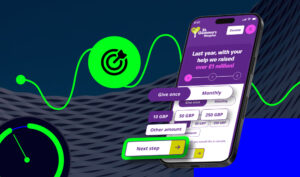Your Guide to Charity Web Design
A charity’s website is the foundation of its online presence. It’s a vital tool for fundraising, creating awareness and building a supportive community. Yet, many charities struggle with outdated, hard-to-navigate sites that fail to engage visitors or drive action.
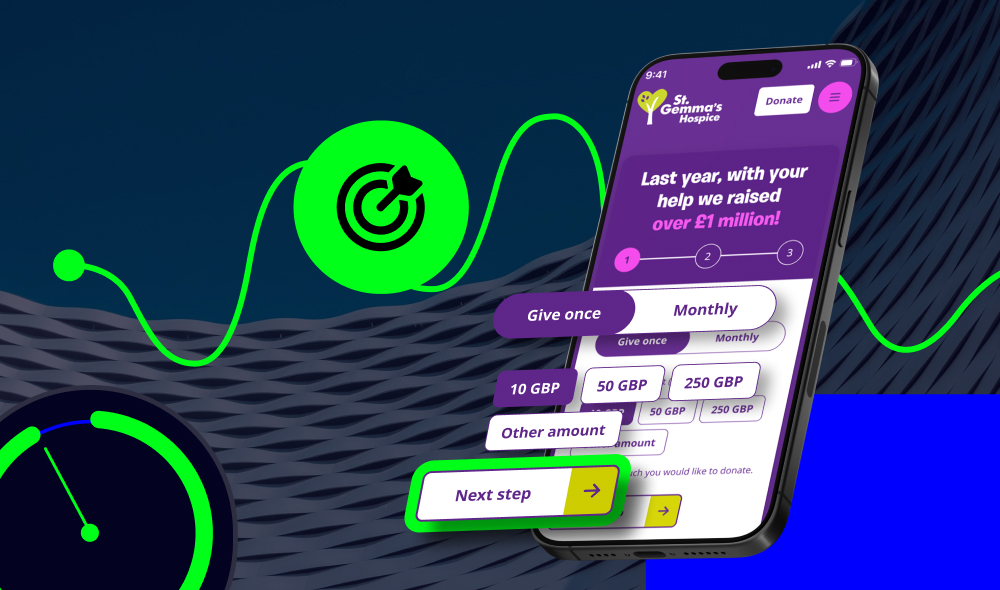
Luke is the Lead Designer at Itineris, specialising in creating compelling digital experiences that blend creativity with strategy. With a strong focus on lead conversions, he crafts user-centric designs that not only captivate but also drive results. His keen eye for detail and passion for innovation ensure brands stand out through engaging visuals and seamless interactions.
With donations increasingly made online and digital campaigns shaping public support, having a well-designed, high-performing website is essential.
But charity web design comes with unique challenges, from accessibility to building trust. In this guide, we’ll break down what makes a charity website successful, the key features to focus on and how to choose the right CMS and hosting for long-term impact.
The Unique Challenges of Charity Web Design
Designing a charity website can be a completely different process from creating a commercial one.
Charities must do more than sell a product or service. They need to inspire action, build trust and serve diverse audiences. This creates unique challenges that require careful planning and execution.
Encouraging Donations
Donations are the lifeblood of most charities. In most cases, securing donations is the key focus of a charity website.
To secure long-term support, websites must make donating effortless and engaging. You also need to ensure making a donation is a positive experience, as repeat donors give 67% more than new donors over time.
This means your charity website should include:
- Clear and compelling calls to action (CTAs): Visitors should never struggle to find the donation button.
- Fast and simple donation journeys: Every extra step reduces conversion rates. Simply removing one form field alone can boost form conversions by as much as 26%.
- Multiple payment options: Including multiple options, like direct debit, PayPal, Apple Pay, and Google Pay increases accessibility and your the ease of making a donation.
A well-optimised donation page can make a massive difference to your charity website’s overall performance. For example, when our team optimised the donor journey on landing pages for Shooting Star Children’s Hospices, we quickly increased landing page conversions by 16%.
Here’s another example of a straightforward and streamlined donation page we created for a charity:

Engaging Volunteers
Many charities rely on volunteers, but websites often overlook this audience.
When planning your charity web design, you need to optimise the site around the various purposes and audience segments your charity serves. This incudes attracting donors as well as volunteer support. In this example, both audiences will require unique content, pages and propositions.
And beyond the content, a confusing or outdated sign-up process discourages people from getting involved. Instead, the best charity websites:
- Clearly highlight volunteer opportunities with dedicated sections.
- Make registration seamless with short forms and instant confirmations.
- Provide engaging content like real volunteer stories, videos, and testimonials to inspire action.
Volunteers are twice as likely to donate as non-volunteers. So, making it easy to get involved can strengthen both participation in the charity and financial support.
Showcasing Impact
People want to see that their support is making a difference. Yet, many charity websites fail to communicate their impact effectively.
To build trust and encourage ongoing support, charities should highlight real stories, photos, and videos rather than generic stock imagery. This builds more of a connection and makes the charity’s work look more compelling.
It’s always a good idea to share key statistics about your charity’s work (e.g. “Your £10 feeds a child for a week”). Publishing clear financial reports to show how donations are used is also a good practice.
Just like case studies and testimonials help businesses convert clients, highlighting charity success stories play a big role in gaining donor participation.
Ensuring Accessibility
Charity websites must be inclusive.
Over 16 million people in the UK live with a disability, yet nearly 96% of website home pages alone have accessibility failures.
Making your website inaccessible is a fast way to exclude potential donors, volunteers, and service users.
To meet basic accessibility standards, charity websites should:
- Use high-contrast text and clear fonts for readability.
- Enable keyboard navigation for those unable to use a mouse.
- Provide alternative text for images and transcripts for videos.
Simple improvements, like increasing text size and ensuring clickable elements are large enough, can make a website far more user-friendly. Although, fully-optimising your website for complete accessibility requires an in-depth approach. You can check out our guide on the power of website accessibility for more details.
As an example of why this is so important, you can look towards our work with Muscular Dystrophy UK. We developed a new WordPress website for them to strengthen their fundraising efforts, build community connections, and share vital condition-related information. A key part of this was to prioritise accessibility and usability. Our approach ensured easier navigation for users with mobility or visual impairments.
Not only has the optimised and accessible site better supported their mission and values, but the improved accessibility has significantly boosted conversions and fundraising efforts.
Building Trust and Credibility
Trust is crucial for charities. People want to know their donations are used responsibly. They want to know that the charities fundraising efforts are creating a positive impact.
A lack of transparency and proof can deter potential supporters. So, to build credibility, charity websites should:
- Showcase charity ratings from organisations like the Charity Commission.
- Include testimonials and impact reports to provide social proof.
- Display security badges to reassure visitors that their payments are safe.
A study found that adding trust badges section on a donation page increased conversions by 42%. Small trust signals can have a big impact.
Key Elements of a Successful Charity Website
Now that we’ve covered some of the key goals and functions of a charity website, here are some of the most important elements you need to achieve this.
User-Friendly Design
An effective charity website must be simple and intuitive to navigate.
Visitors should quickly find the information they need, such as donation buttons, volunteer opportunities, and contact details. In fact, 88% of users won’t return to a site after a poor experience, making ease of use essential.
Some best practices to get this right include using a clean, uncluttered layout. Ensure you have clear headings and logical navigation. Provide a search function for quick access to content.
And when it comes to content, you can’t underestimate how important it is. Make sure that your charity website offers plenty of helpful content to support all of your different audience segments and goals. If users can’t easly find the information they need, they will quickly abandon the site.
Mobile Optimisation
Over 62% of website traffic comes from mobile devices. Needless to say, proper mobile optimisation is critical.
A mobile-friendly site ensures accessibility across all screen sizes and keeps visitors engaged. It also means user and donor journeys are simple, regardless of where they’re coming from.
Use responsive design that adapts to different screen sizes. Avoid small fonts and cramped layouts. And always test your loading speeds – slow sites lead to higher bounce rates.
This is something that’s easy to overlook, but plays a vital role in your overall digital success.
Seamless User Journeys
As we’ve already covered, donating should be quick and hassle-free on your charity website. Optimising donation pages can massively increase conversions.
Don’t just take our word for it – our work with Cransley Hospice Trust involved optimising accessibility and ease of navigation on their new website build. Through a streamlined donor journey, we managed to increase the lead conversion rate by 32% and increase donations by 17%. This was all through simply streamlining key pages and registration processes.
Make sure that you have key donation pages with clear CTAs. These pages need to be easy to find, with donation forms that are quick and easy to fill out.
Compelling Storytelling and Visual Appeal
Storytelling is one of the most powerful tools charities can use. People connect with real stories, not statistics alone.
For a charity website, effective storytelling includes:
- High-quality images and videos showing real impact.
- Beneficiary testimonials that bring the cause to life.
- A clear, emotional narrative explaining why support matters.
After all, making a case for charities is all about building emotional connections. This is why its so important that your charity website inckudes plenty of content about its mission, work and impact, with real-life stories.
Clear Calls to Action (CTAs)
This is a simple one, yet its something that far too many websites don’t get right.
Visitors should know exactly what to do next, whether it’s donating, signing up for a newsletter, or volunteering. This involves using strategic CTAs that use direct, action-oriented text like “Donate Now” or “Join Us Today.”
Make sure you place CTAs prominently on key pages so that users can always find the option to take action. They should never have to search for the next step.
Importantly, use contrasting colours to make buttons stand out. Your CTA shouldn’t be too pushy, but good web design needs to make these buttons the clear focal point of your charity web pages.
Search Engine Optimisation (SEO)
Research shows that 53% of website traffic comes from organic search. This is far more than any other channel, which makes SEO a crucial aspect of charity digital success.
In the most simple terms, good SEO helps charities reach more people. If your site isn’t properly optimised for search engines and your target audience’s queries, you’ll quickly lose support and traffic to other organisations.
There’s a lot that goes into SEO, especially when it coems to a large-scale charity website that serves diverse audiences. A good technical foundation, relevant keyword optimisation and valuable content make up some of the key features. However, there’s a lot more that goes into winning search results than just this.
Speak to our expert team if you need SEO help. We’ve helped many charities optimise their organic presence – like our work with Forget Me Not Children’s Hospice which helped them generate an 84% increase in organic traffic. This all comes down to a clear strategy and ongoing optimisation.
Social Media Integration
This article may be about charity web design, but as a charity, your website is only one arm of your digital presence. Sure, its your most important digital asset, but you need to make it part of a multi-channel strategy.
Social media extends a charity’s reach and encourages engagement. 55% of people who engage with charities on social media go on to take action, which shows just how important it is to streamline the connection between your social channels and your site.
This can involve adding social sharing buttons to key pages or embedding social media feeds into your site for real-time updates. The main idea is to always provide easy ways for visitors to follow and interact with your charity.
By aligning your site with your social channels, you simply create more opportunities to attract support, engage your audience and generate funding.
Transparency and Trustworthiness
Trust is crucial for charities.
Donors want to know where their money goes, and they want to know that donations are making a tangible impact. A lack of transparency can quickly discourage support and tarnish your reputation.
Your website is crucial here, because its the main digital platform where you can open up about the charity and share your successes.
You can build trust by displaying financial reports and impact metrics on your site. Feature real stories of how donations help your cause, and show accreditations, partnerships and testimonials.
Being consistent with communication is important, as it shows that your charity is actively doing good work.
Security and Compliance
In today’s world, no organisation can take digital security lightly.
A secure website protects donor data and reassures supporters. With data breaches becoming more common, charities must prioritise online security.
And again, this ties back to trustworthiness in the previous point.
Security essentials include:
- Use SSL encryption (HTTPS) for secure browsing.
- Ensure GDPR compliance for handling personal data.
- Partner with reputable payment processors for donations.
But really, this is only scratching the surface. When developing your charity website, make sure that you work woith partners who have a deep understanding of security and how to maintain it.
That’s one of the reasons why we offer an ongoing Protect service, ensuring charity websites stay secure and compliant long after their launch.
Charity Website CMS and Hosting Considerations
When considering charity web design, another essential factor is, of course, the platform you’ll be building your website on. This is where choosing the right content management system (CMS) and hosting solution is so important for any charity’s digital success.
Many charity websites grow over time, adding onto their website with donation platforms, volunteer sign-ups, event pages and impact reports. This is why yu need to consider the future and how your CMS can handle future demands.
A scalable and flexible CMS (like WordPress VIP) ensures charities can expand their digital presence without performance issues.
WordPress powers around 43% of websites worldwide, offering a user-friendly interface, powerful integrations and enterprise-level security. And if your charity needs a network of sites, such as localised sites under the same charity group, you can use WordPress Multisite.
Reliable hosting is just as important. Charities need a platform that can handle high traffic demands, especially during fundraising campaigns or viral awareness drives.
Kinsta, our preferred hosting solution, is a good option, delivering speed, security, and scalability. You need this to ensure charity websites remain fast and accessible, even under heavy demand.
A well-hosted site improves SEO rankings, donor trust and overall engagement, making it a crucial part of a charity’s long-term success.
By investing in the right CMS and hosting, charities can create a robust digital foundation that supports their broader goals — whether that’s increasing donations, reaching more beneficiaries or strengthening their brand.
A poorly built or slow website can cost charities valuable support, while a well-optimised, secure platform helps them grow and make a bigger impact.
This is a crucial consideration, and one of the most important investments in your overall digital presence.
Charity Web Design Examples
All that said, let’s take a look at some examples of effective charity web design projects.
Here are a few of the charities and non-profits that we’ve worked with at Itineris. While each project was different, they all involved optimised websites with streamlined and accessible user journeys. In all of the cases, the updated web designs helped the charities increase their reach, engagement and online success.
Click on the links below to explore the websites.
Shooting Star Children’s Hospices
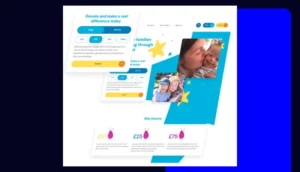
Forget Me Not Children’s Hospice
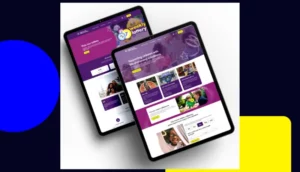
East Anglia Children’s Hospice
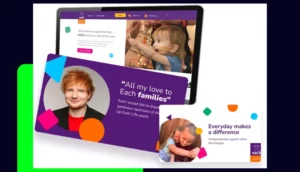
Muscular Dystrophy UK
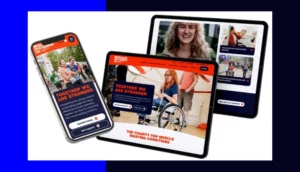
Cransley Hospice Trust
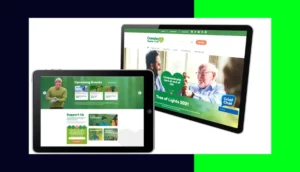
Motor Neuron Disease Association
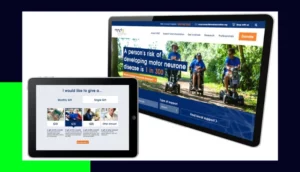
Work With an Experienced Charity Web Design Agency
A great charity website should look good and work hard. It needs to inspire action, build trust and make donating effortless. This is why carefully choosing the right design, functionality and technology can mean the difference between a thriving digital presence and a site that gets ignored.
Investing in a scalable CMS and reliable hosting ensures your long-term success, and will help your charity keep up in a fast-paced digital environment.
Most importantly, you’ll want to work with the right team to strategise, build and grow your charity. At Itineris, we have over 23 years of experience developing websites and digital strategies for top charities. Get in touch to see how we can help you.


